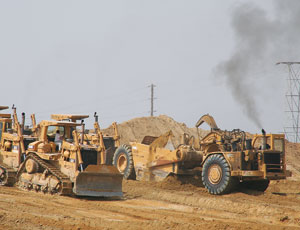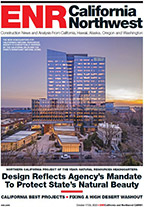California contractors are breathing easier but environmentalists feel smoked after a last-minute proviso to relax California’s off-road-diesel emission regulations made it into the state’s final budget, which passed the state legislature on Feb. 19 after five months of contentious negotiations.

The California Air Resources Board had developed the rules for existing equipment set to kick in next year. Now, it gives extra credit to fleets that started reducing emissions prior to the mandate, thanks to extreme lobbying pressure from the construction industry.
Groups flexing their political muscles included the Associated General Contractors of California, Construction Industry Air Quality Coalition and Coalition to Build a Cleaner California. State Sen. Jeff Denham (R) authored the deal-making late amendment, SB 8, which passed without any discussion. But the move marks a setback for environmental groups. “This ruling came about because of the state’s archaic two-thirds vote requirement, and a dwindling minority of Republicans can use their leverage to tag on nonfiscal issues in bills as favors for their contributors,” says Bill Magavern, Sierra Club’s director in California.
AGC of California had been fighting the mandate for years. It says the new modifications include providing additional credits for those fleet owners that already have retrofitted or sold off portions of their equipment fleets. In addition, legislators and others have recognized that an economic downturn in construction is resulting in reduced operating hours, so affected fleets can now receive credit.
The trade groups worked on the deal “diligently and purposefully over the past two years,” says Gary Rohman, vice president of ECCO Equipment Corp. in Visalia and president of CIAQC. “This agreement represents a significant change to the rule, but more importantly, it acknowledges that the regulation needed to be reviewed and modified.”
The original CARB rule would have cost contractors and equipment owners $13 billion, AGC reports. For the first time, CARB required that pollution controls be installed on existing off-road diesel engines in construction equipment and that engines be retired if they cannot comply. The regulation was designed to reduce existing off-road diesel emissions by 85% through 2020.
Contractors are still required to meet the emission cuts on an annualized, sliding scale, but the rule now includes three main provisions that relax the rules in the first three years. First, contractors will be given full credit for any vehicle retirements made between March 1, 2006, and March 1, 2010, as long as their total fleet horsepower decreased from the previous year. These credits do not expire.
Second, contractors may carry forward a credit for reduced fleet activity based on their percentage reduction in annual fleet hours for the year ending July 1, 2007, to the year ending March 1, 2010. Those credits may only be used for 2010 and 2011. And finally, fleets may meet the standards by completing 20% of the work in 2011, 20% more in 2012 and the balance in 2013. Fleet owners that have not yet made any emission cuts must still hit the original 2010 start date.
Industry groups have questioned the state’s authority to impose such stringent standards. Federal rules set by the U.S. Environmental Protection Agency in 2004 impose emissions requirements on all new off-road diesel engines and fuel but do not mandate cuts to existing engines. Although CARB is still seeking a waiver from EPA to enforce its standards, the delay will not affect it, a CARB spokesperson says. Beth White, an air-pollution specialist for CARB in Sacramento, says the board has “no comment” on the new legislation, but she emphasizes the importance of controlling particulate and ozone pollution, of which construction equipment is tagged as a major source.


Post a comment to this article
Report Abusive Comment